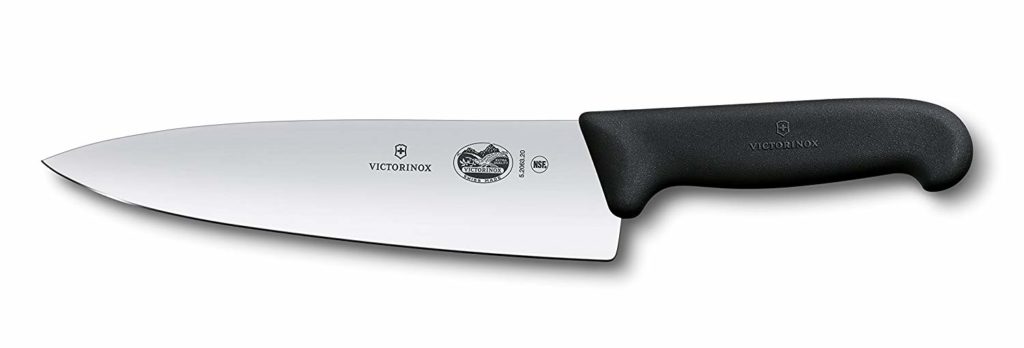
Since knives come in a wide range of sizes and styles and can vary in price from a few dollars to a couple hundred dollars, people are often intimidated when buying knives. Hopefully I can help get you started with a few basics.
Most of the recommendations below are high quality and inexpensive knives by Victorinox that can ease you into knives. With experience you may find that you want a different weight or feel from your knives, and if that happens you won’t have spent a lot of money on your starter set of knives.
I have found that I can do everything I need in the kitchen with just four knives, and since we don’t eat much bread in our household, one of the four almost never gets use.
1) an 8″ chef’s knife
2) a paring knive
3) a serrated bread knife
4) a 5″ chef’s knife (this one was a surprise!)
8″ Chef’s Knife
My hunt for knives started with the Cook’s Illustrated recommended Chef’s knife, the Victorinox Fibrox Pro 8″ Chef’s Knife. It is inexpensive (about $35) but made of good steel that holds an edge well. I particularly like the textured plastic “Fibrox” handle because it doesn’t get slippery when wet. The light weight of the handle also keeps the overall weight of the knife down.
Paring Knives
Next on the list is a paring knife. With a chef’s knife and a paring knife you can do almost everything in a kitchen.
I started out with a Victorinox 3.25″ paring knife which worked well. On a whim I bought a 4″ version of the paring knife. With both knives in the kitchen I found that I used the 4″ knife a lot more often than the 3.25″ knife. The extra length allows me to cut things that are too thick for the standard 3.25″ length (apples, tomatoes, onions, etc). At the same time my mother-in-law prefers the 3.25″ size, and she now has three in her kitchen!
The good news is that each is under $10, so you might want to get one of each and see what you prefer.
Bread (serrated) Knife
Since my household doesn’t eat much bread, I don’t have good personal experience with bread knives. I have a Gerber 8″ bread knife that is heavy and has a slightly bent tip. But since I almost never use it, this doesn’t pose a problem for me.
But I understand that many people eat bread, and that bread knives can have other uses (cutting tomatoes, meat, etc). I will pass on the recommendation by Cook’s Illustrated for the Mercer Culinary Millennia 10″ bread knife. At about $20 it is a bargain, and I might just have to get one myself to try it out!
5″ Chef’s Knife
Finally we get to the 5″ chef’s knife. The Victorinox Fibrox Pro 5″ chef’s knife is kind of a funny looking knife, with a very light and thin chef knife shaped blade and a full sized handle. Once again the Fibrox handle means it doesn’t get slippery when wet.
Strangely this knife gets a ton of use in my kitchen. Given the short blade it works well with smaller sized cutting boards, or when you are just cutting a few things. I find that most ingredients can be cut with the 5″ blade, and I only grab for my 8″ chef’s knife if I need to cut things wider than 4″ or chop things with a full rocking motion on a large cutting board.
The shape and small size of the blade also allows it to be used for finesse work, and I use it every week to debone chickens.
Knife Sharpener
So now you have your knives, but only slightly worse than having no knives is having dull knives! Dull knives are actually more dangerous, because you have to press with more force to cut. And if your ingredient rolls or shifts on you, that forceful cut may get aimed at you instead of your food.
I have limited experience with knife sharpeners because I found a simple inexpensive sharpener years ago and never looked back. Cook’s Illustrated recommended the AccuSharp knife sharpener (#001C), and that was good enough for me.
It sharpens in an interesting way, so you should watch this video before buying it.